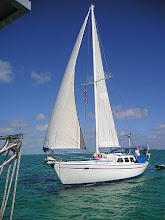
To prepare for our 6-month journey to the mainland of MX we have provisioned to the hilt and have loaded most of the items on board (see photo of Chandler with luggage and Doug loading) while still living in our Loreto house. Once the goods were on board it was Ann's job to stow everything in drawers, hide-away storage bins, and closets. Check out how efficient storage on board is with under-the-seat bins that can hold tons of canned goods!


Doug works daily on boat prep and the many maintenance issues always at hand while I home-school the children in the mornings and work at my desk pre-paying bills, finishing up business bookkeeping, writing a few last minute blog entries while we have a strong internet connection, and the usual laundry and cooking activity. We all look forward to this adventure with great excitement and to letting go of some of the daily grind that accompanies land-life. It's not that the same chores and responsibilities don't exist onboard but we tend to live a simpler life which requires less of the day-to-day rushing around and activities.
As we spend time at the port, where our boat is moored, we run into cruiser friends who share their experiences with us and that fuels our excitement even more. They also give us helpful information about what type of weather to expect down the coast as well as provisioning ideas, restaurant locations, and best beach locations.
Today we took the local Tabor Canyon hike, which we have done numerous times, with cruiser friends. We went further then we typically do and much further than the kids have gone on previous hikes here. The views from way up in the canyon are striking to say the least. Palm trees, views of the Sea of Cortez, and canyon walls surround us while a small level of water trickles down the upper parts of the boulders. Less water up here is a clear indication of the lack of rain this area received this summer/fall. No hurricanes in this region this year, thus the low water level. We wonder how that affects the local ranchers and their livestock.
Speaking of livestock, as we drive the road to town and back we see plenty of cattle and horses grazing right at the edge of the road. Sometimes we see the casualty of that activity but mainly we see drivers forewarning other drivers of animal sightings. We follow suit and have learned that flashing blinkers from oncoming cars sends the message that animals are nearby so slow down. It’s only one of a few signals drivers use on the Baja that have become standard communication between motorists. Having driven the 700+ miles to the US and back many times we have become accustomed to those signals and use them ourselves. One that confused us the first few times we saw it was when a driver in front of us would signal that he was going to make a left-hand turn, yet we saw nowhere he could turn of the road. We now understand that it means, “the road up ahead is clear of oncoming traffic and you can pass me if you want to.” Since most of the main road here is one lane per direction the driver in front of us becomes our eyes as we use the oncoming lane as our passing lane. The tricky thing about that “passing signal” is when someone in front or us really is going to make a left turn and uses his turn signal. We have to be very careful not to speed up and pass them as they are making their turn!?! Good info to have if you are considering driving in Baja!








No comments:
Post a Comment